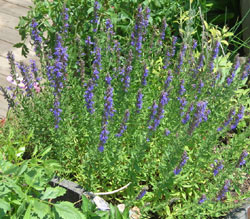
While repellent to some pests, the licorice-scented foliage of hyssop is appealing to gardeners.
Question: I have been seeing online that companion planting helps control pests and improves the growth and flavor of vegetables. Can you provide more information?
Answer: Many plants are known to deter pests and/or attract beneficial wildlife. Some of them make great companion plants for the vegetable or ornamental garden. Aromatic compounds within marigolds, nasturtiums, onions, chives, hyssop, rosemary, catnip, thyme, and others help ward off insect and animal pests. Many of these repellent plants also produce lots of nectar to attract beneficial pollinators. It’s a win:win situation.
Question: What is the difference between annuals and perennials? I have a steep
hill in my yard and only want to plant things that will come up year after
year.
Answer: The answer is not as straightforward as it seems. Technically, an annual completes its life cycle from seedling to senescence (death) within a year. Perennials live at least three years and many perennial plantings will last for decades. Those are the actual definitions.
However, in horticultural practice, the definitions can vary a bit. Depending on your location, some perennials are treated as annuals. Subtropical and tropical plants growing in cold climates will not survive the winter and are therefore grown and labeled as annuals in those zones. For instance, gerbera daisies, castor beans, and nasturtiums are sold as annuals in Chicago but as perennials in San Diego.
Complicating matters are annuals that “volunteer” or return from seed every year. These prolific reseeders (cleome, balsam, dill, larkspur, morning glory, viola, etc.) can create perennial patches in the garden, although each individual plant only lasts a season.
In your case, a combination of true perennials and reseeding annuals might keep your hill growing and blooming with just a little maintenance. Good luck.

Hydrangea arborescens bursts forth with fast growth in spring and blooms all summer.
Question: I'm looking for ornamentals that can handle shade: trees, shrubs,
and annuals or perennials. Can you suggest a list?
Answer: This is a topic for a future issue, but here is a short list of plants that do well in partial shade. Check local garden centers for cultivars and varieties that do well in your area.
Ornamental trees: Japanese maple, camelia, ironwood (Ostrya virginiana), hemlock
(Tsuga), yew (Taxus)
Shrubs: spicebush (Lindera), rhododendron, bush honeysuckle (Diervilla), smooth
hydrangea (Hydrangea arborescens)
Perennials: clivia, hellebore, ferns, elephant ears (Colocasia), bleeding hearts
(Dicentra spectablis)
Annuals: nemophila, wishbone flower (Torenia), coleus, impatiens, monkey flower
(Mimulus)
Question: I have some potted hyacinths that bloomed in March and I am not sure
what to do with them now. I live in Vermont and couldn't place them outdoors
but would like to, and wondered when would be a good time to do that? The
leaves are beginning to wilt and turn yellow. Should I wait until the leaves
die off and plant the bulbs in the fall? Should I continue to water them?
Is there a good Web site that would have these answers that you would recommend?
Answer: This is no easy task, and many people simply choose to compost them. However, if they have sentimental value, after they bloom treat the forced bulbs like bright light houseplants. Place them in a sunny windowsill (the cooler the better). Regularly water and fertilize, taking care not to overwater. Some yellowing and dieback of leaves should be expected. Monitor closely for signs of mold or rot. Plant outside as soon as the frost date has passed.
Some gardeners find the effort exceeds the payoff. Forced bulbs rarely bloom the next year and may take several years to recover. It is often simpler to compost the forced bulbs, buy new bulbs in the fall, and use the compost to feed the new plantings.